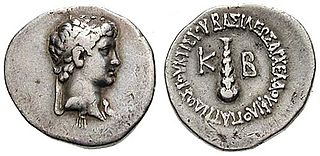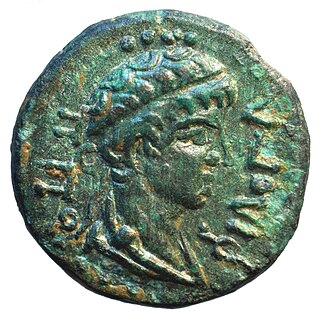Related Research Articles

Gaius Julius Antiochus IV Epiphanes, the last king of Commagene, reigned between 38 and 72 as a client king to the Roman Empire. The epithet "Epiphanes" means "the Glorious".
Iotapa may refer to:

Archelaus was a Roman client prince and the last king of Cappadocia. He was also husband of Pythodorida, Queen regnant of Pontus.
The Orontid dynasty, also known as the Eruandids or Eruandunis, ruled the Satrapy of Armenia until 330 BC and the Kingdom of Armenia from 321 BC to 200 BC. The Orontids ruled first as client kings or satraps of the Achaemenid Empire and after the collapse of the Achaemenid Empire established an independent kingdom. Later, a branch of the Orontids ruled as kings of Sophene and Commagene. They are the first of the three royal dynasties that successively ruled the antiquity-era Kingdom of Armenia.

Gaius Julius Antiochus Epiphanes Philopappos or Philopappus, was a Prince of the Kingdom of Commagene who lived in the Roman Empire during the 1st century and 2nd century. He was one of the most prominent Greeks in the Empire.

Commagene was an ancient Greco-Iranian kingdom ruled by a Hellenized branch of the Iranian Orontid dynasty that had ruled over Armenia. The kingdom was located in and around the ancient city of Samosata, which served as its capital. The Iron Age name of Samosata, Kummuh, probably gives its name to Commagene.
Mithridates III Antiochus Epiphanes was a prince who served as a King of Commagene.
Antiochus III Epiphanes was the ruler of the Kingdom of Commagene from 12 BC to 17 AD. He was the son and successor of King Mithridates III of Commagene and Iotapa, and of mixed Iranian, Armenian, Greek and Median descent – the last through his mother. His parents were first cousins.
Julia Balbilla was a Roman noble woman and poet. Whilst in Thebes, touring Egypt as part of the imperial court of Hadrian, she inscribed three epigrams which have survived.
Gaius Julius Archelaus Antiochus Epiphanes, also known as Julius Archelaus Epiphanes; Epiphanes; Gaius Julius Antiochus Epiphanes or simply known as Gaius was an influential prince of the Kingdom of Commagene, who lived in the 1st century.
Callinicus was a prince of the Kingdom of Commagene, who lived in the 1st century AD. Callinicus was the second-born son and child to King Antiochus IV of Commagene and Queen Iotapa of Commagene. His parents were full-blooded siblings. His parents were Roman Client Monarchs of Commagene that lived under the Roman Empire in the 1st century. His older brother was prince Gaius Julius Archelaus Antiochus Epiphanes and youngest sibling was princess Iotapa.

Cappadocia was a province of the Roman Empire in Anatolia, with its capital at Caesarea. It was established in 17 AD by the Emperor Tiberius, following the death of Cappadocia's last king, Archelaus.
Archelaus was a Cappadocian prince and a Roman client king of Cilicia Trachea and Eastern Lycaonia. He is sometimes called Archelaus Minor and Archelaus II to distinguish him from his father Archelaus of Cappadocia.

Classical Anatolia is Anatolia during classical antiquity. Early in that period, Anatolia was divided into several Iron Age kingdoms, most notably Lydia in the west, Phrygia in the center and Urartu in the east. Anatolia fell under Achaemenid Persian rule c. 550 BC. In the aftermath of the Greco-Persian Wars, all of Anatolia remained under Persian control except for the Aegean coast, which was incorporated in the Delian League in the 470s BC. Alexander the Great finally wrested control of the whole region from Persia in the 330s BC. After Alexander's death, his conquests were split amongst several of his trusted generals, but were under constant threat of invasion from both the Gauls and other powerful rulers in Pergamon, Pontus, and Egypt.
Iotapa was a princess of Commagene, daughter of King Mithridates III of Commagene. She became the Queen consort of Syrian King Sampsiceramus II of Emesa.

Julia Iotapa, or simply Iotapa, daughter of King Antiochus III of Commagene, was Queen of Commagene, consort of her King brother Antiochus IV.
Julia Iotapa or Julia Iotape, daughter of King Antiochus IV of Commagene, was a Queen of Cetis, consort of Gaius Julius Alexander, son of Herodian prince Gaius Julius Tigranes.
Julia Iotapa or Julia Iotape, sometimes known as Julia of Cilicia, was a Cilician princess who lived in the 1st century and 2nd century. Daughter of King Gaius Julius Alexander of Cetis, she married Gaius Julius Quadratus Bassus, Galatian Roman Senator from Anatolia.